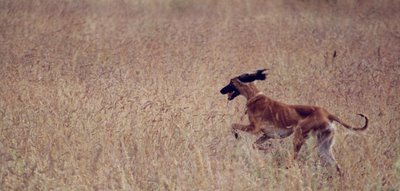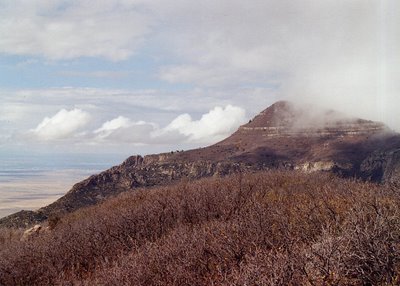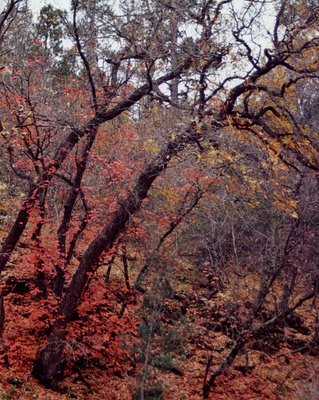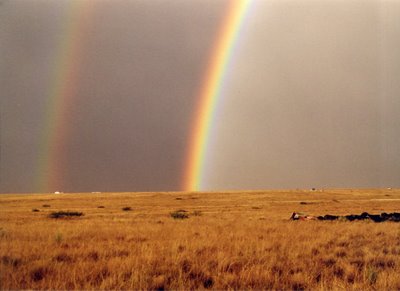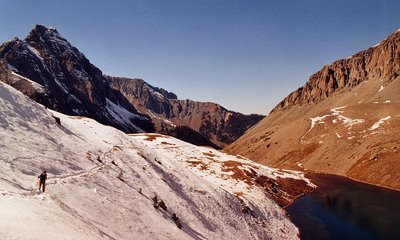(Via Natalie Solent)
Monday, October 30, 2006
Tuesday, October 24, 2006
Sunday, October 22, 2006

 Das wüthende Heer: right to left, Plummer (lurcher), Ataika, Larissa (pretty sure), Lashyn (forequarters).
Das wüthende Heer: right to left, Plummer (lurcher), Ataika, Larissa (pretty sure), Lashyn (forequarters).
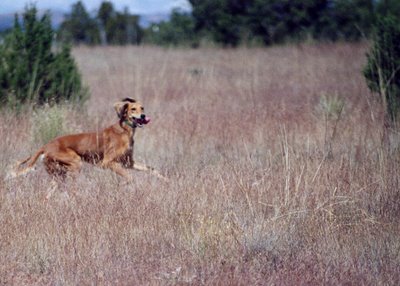
 Kiran, the male tazi. Tazi bitches like to be fea, fuerte y formal; Kiran not so much.
Kiran, the male tazi. Tazi bitches like to be fea, fuerte y formal; Kiran not so much.
I really should come on one of these outings with more than half a roll of film. It's no problem at all to burn through frmaes tracking lightning-swift dogs through the New Mexico savannah. I took my last shots as we looped back around towards the car. Very shortly after, I was walking ahead of eveyone else, and bumped a jackrabbit. I yell, "Hai! Hai! Hai," the dogs are conveniently near, the pack wheels and pursues. Tazis seem fast at a lope, remarkably fast at an excercise pace; but these speeds are nothing compared to their pursuit. Already rocketing, the dogs suddenly engage a whole 'nother gear, flying ahead towards the rabbit, who suddenly realizes that these are not like other dogs and that he's actually in a good deal of trouble. A cottontail would be doomed, but jacks can fly along themselves, and twist and turn. The hare carves a serpentine path across the fields, a whiplash of sighthounds following and gaining. At one moment, the jack is running straight at me, the line of dogs behind, closing the gap on the straightaway; my camera, of course, remains empty. More twists, more pursuit. Lashyn is a noselength behind when she slips on a patch of mud. The hare escapes by the skin of its teeth.
******************************
Saturday, October 21, 2006
It is to be supposed that the last family of Atures did not die out until a long time afterwards: since at Maypures - bizarrely - there still survives an old parrot that nobody, say the natives, can understand, because it speaks only the language of the Atures.The only record of the Ature language was preserved by a bird! Hat tip: dr.hypercube.
Friday, October 20, 2006
Thursday, October 19, 2006
Two weeks ago, we headed to Magdalena to visit the Bodios. Unsurprisingly, we ate well and drank much, and saw some brilliant sunsets in joint celebration of two couples' anniversaries. On Sunday, we went out, accompanied by two tazi bitches, to Central New Mexico's Manzano Mountains, a place I had visited previously alone.
The Manzanos are not a mountain range you'll hear much about. They wouldn't do well on postcards or in Sierra Club calenders. They top out at just barely over 10,000 feet, which would be a pretty respectable summit in Idaho or Washington; down here, its not that high, well below the timberline. To put it bluntly, not too many people are interested in these mountains, and I'm optimistic that not many ever will be.
So why should one go, with Colorado's spectacular peaks beckoning not to far to the north? In short: for biodiversity. The Manzanos, particularly in their northeastern quarter, are remarkably well served with rainfall, and the vegetation is explosively lush by Southwestern standards. You sense immediately that you are no longer in the Southern Rockies, as up by Santa Fe. The ubiquitous pinon and juniper are present of course; the nearby Rockies contribute spruce, fir and a few aspens; and the ponderosa pines are very tall and prosperous. But the conifers are largely punctuation set within extensive groves of oak and bigtooth maples. Deciduous trees are always a novelty in New Mexico, and these lush, vast stands of broadleafs are unheard of.
The Manzanos, like their neighbours on either side, are a block-fault range formed by the Rio Grande Rift, asymmetrical, with a steep western scarp falling towards the flats by the river, in contrast to hillier and gentler eastern approaches. As we drove up out of the rift on our way to the trailhead, over Abo pass, rain began falling heavily, steaming the car, defroster struggling and windows cracked. We couldn't see the mountains at all through the clouds and rain as we drove north to the trailhead, our optimism for the hike on the wane. These eastern foothills of the Manzanos were one of the first areas of European settlement in New Mexico outside the Rio Grande valley. The ruins of large churches and extensive settlements are scattered about the area: Abo, Quarai, Gran Quivira. This is the far uphill edge of the Great Plains, and the Indians gathered salt on flat playas to the east for trade. As the story goes, the first Spanish traders who ventured out of the valley seeking the source of the salt found mature apple trees growing here, apple trees whose zeal to colonize evidently outdid that of the conquistadors and missionaries. (Apples, if you've forgotten, come from the Altai mountains in Kazakhstan.)
Some modern settlements hang on out here as well. Estancia and Mountainair are down-at-the-heels high plains towns, with some splendid old brick buildings and ranch houses and not much else, sustained by the railroad and the ranches to the east, flanked on the west by the Manzanos and on the south by the cloven, haunted, empty badlands of the Los Pinos mountains. Closer to the mountains are several Spanish land grants and their eponymous villages, Punta de Agua, Manzano, Torreon and Tajique, beautifully run-down Spanish villages laced with seasonal creeks from the mountains, of the sort that have mostly been bought out by yuppies up north. We drove past perfect village churches, skeletons of gers, hogans, undefinable structures, general stores; there's a Sufi center outside of Torreon. At Tajique we hung a left up a canyon of high plains sandstone strata tilted up by the rift, into increasingly opulent vegetation.
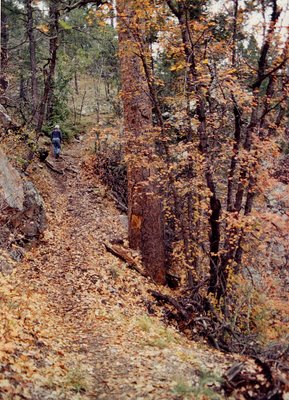
 The rain broke. We walked uphill towards the crest. The tazis pushed ahead, but even they were largely kept to the trail by the dense oak underbrush. We had come hoping for fall colours in the state's best deciduous wood. We found a little bit of everything: lots of bare trees, the ground strewn with brown; lots of lush green stands looking determined not to acknowledge autumn one bit; and a few brilliant splashes of orange and red fall brilliance. When I had come here before, in late summer, there had been many wildflowers. A few lingered on under the autumn canopy: Jacob's ladders, harebells, many I didn't know. Small, trickly waterfalls in the gullies provided a soundtrack.
The rain broke. We walked uphill towards the crest. The tazis pushed ahead, but even they were largely kept to the trail by the dense oak underbrush. We had come hoping for fall colours in the state's best deciduous wood. We found a little bit of everything: lots of bare trees, the ground strewn with brown; lots of lush green stands looking determined not to acknowledge autumn one bit; and a few brilliant splashes of orange and red fall brilliance. When I had come here before, in late summer, there had been many wildflowers. A few lingered on under the autumn canopy: Jacob's ladders, harebells, many I didn't know. Small, trickly waterfalls in the gullies provided a soundtrack.
We had also come hoping to see birds of prey at the crest. Early October is raptor migration season, indeed Hawkwatch maintains a seasonal site in the Manzanos, but as we ascended through thick tendrils of mist worthy of a Chinese landscape, our hopes for birds diminished. We did see bear excavations in the soil.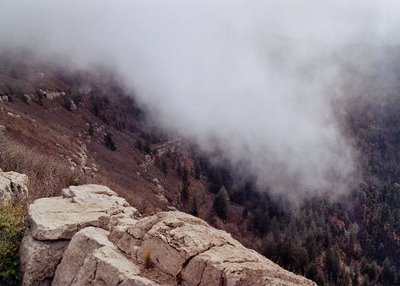

Toward the crest, the larger trees thinned out, leaving only a head-high carpet of dense scrub oak. We were not optimistic about views, but as we reached the top the mists began rolling back as if on request, and we looked down the steep western slope of the mountains, striped with limestone terraces, to the broad plain stretching out toward New Mexico's great river. Steve, with his almost supernatural radar for avian life, picked out two sharp-shinned hawks at the top; I caught a fleeting glimpse of the second as it vanished into fog.

 As we descended, the mist moved back in and threatened more rain.
As we descended, the mist moved back in and threatened more rain.
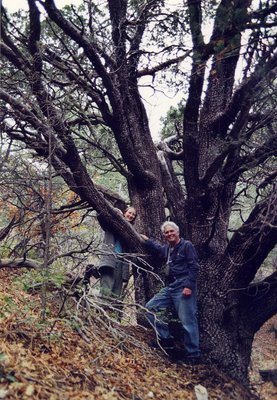
 Steve and Mrs. Peculiar show off a truly enormous Alligator Juniper, prime specimen of Manzano Mounatin fecundity!
Steve and Mrs. Peculiar show off a truly enormous Alligator Juniper, prime specimen of Manzano Mounatin fecundity!
We drove out through the back roads, through idyllic mountain valleys, the kind that leave you wondering how many people it would be necessary to kill to own the place. My Subaru came through admirably, as always (Cars like flattery! And rugged outings!), in the thick patches of rain-sodden mud. We passed the sufi center and popped out at Torreon in another driving rainstorm. The precipitation in Central New Mexico that weekend was off the charts. We saw numerous arroyos flooding on the drive back to Magdalena, always a cheering sight. (Although Utah really received the brunt of the flooding: hundred-year records! Here also!) As we came back down Abo Pass, well, I'll let a better writer choose the words:
On the way back we drove into the heart of a thunderstorm, backlit by the sunset; descending the steep western slope was like flying into it in a plane. We drove through and looked back to see what we all agreed was the most perfect rainbow we had ever seen, a complete arc backed by the nearly- black thunderhead but rooted in the golden plain.
In Central New Mexico, you don't get a pot of gold at the end of the rainbow, you get piles of tires and meth shacks! Thank God it's been a rainy year: New Mexico's squalor receives just as much rain and beautiful atmosphere as its opulence!
Please view the pictures at full size, if you are so inclined. Coming up: the Manzano Mountains, and tazis!

Mrs. Peculiar looks down on the second of the three Blue Lakes. 
The blessing of an intrepid wife! 


Looking down on the uppermost Blue Lake; Blue Lake #2 is also barely visible.
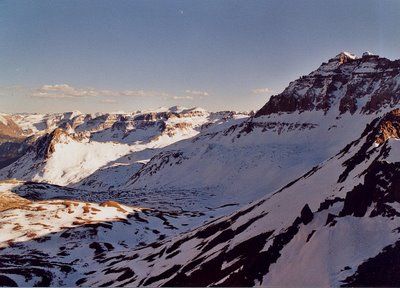
 View of Gilpin Peak, looking southeast from the top of Blue Lakes Pass. We could see, with envy, ski tracks down the face of the small peak to the right. We also saw a glider, allegedly a local out of Telluride, soaring about overhead.
View of Gilpin Peak, looking southeast from the top of Blue Lakes Pass. We could see, with envy, ski tracks down the face of the small peak to the right. We also saw a glider, allegedly a local out of Telluride, soaring about overhead.
Sunshine Mountain (left) and Wilson Peak (right). A small jet recently crashed into the very top of Wilson; 14,000 feet is not necessarily a safe altitude around here!
Saturday, October 14, 2006
“While I was up the mountain, pursuing my personal dream, other people were trying to pursue theirs...some 80 tibetan people were trying to cross Nangpa La into Nepal and from there to Dharamsala, India, on a pilgrimage to see the Dalai Lama,” reported Alex. “They were men, women and children, barely wearing decent winter clothes. After an actual human hunt, 8 of them won’t live to see their dream fulfilled. They have been killed in cold blood by the Chinese militia after a snitch between them. This happened in front of many expedition teams. The dead were simply buried in the glacier and left there without any memorial symbol.The Romanians went through such things in living memory. Here's a Romanian broadcast video of the shootings.”Big expedition outfitters like HiMex, Jagged Globe, Adventure Consultants or Alpine Ascents will never speak about that. Otherwise they will be banned from the Tibetan side of the Himalayas. And this will mean no more bucks for them anymore. And they don't want that, of course. It has indeed nothing to do with the spirit of mountaineering (which has been lost in those commercial outfits) but with the basic human values.”
(Hat tip for all this information: Summitpost.)
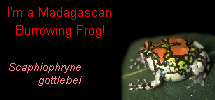
Found in the dry, hilly regions of south central Madagascar, these amazing frogs escape the searing heat and dry winds of the region by burrowing into the ground for the duration of the dry season. Very shy by nature, when threatened, these frogs inflate themselves and will not hesitate to charge their assailants. These frogs can be very gluttonous, devouring a wide variety of bugs, grubs and the like.
Wednesday, October 11, 2006
"Wolf howls prompt wilderness evacuation, Frightened Forest Service employees extracted"
Hat tip: Roseann.

Vasey's Paradise, one of many springs that flow from the Grand Canyon's walls. The Redwall Limestone is highly water permeable and riddled with caves. It's lower neighbour, the Muav Limeston is much less permeable, so a large number of springs in the Canyon issue forth at the Redwall-Muav contact. The spring at Vasey's has noticeably diminished in volume over the years, even within my own memory. It is one of the few homes of the endangered Kanab Land Snail (the Park Service occasionally issues risible missives exhorting the public to "minimize human-snail conflict"), and up close is well-endowed with red monkeyflowers and poison ivy. 
Wednesday, October 04, 2006
...automatic language identification systems, which attempt to determine what language a sample of unknown text is written in, needlessly endanger the sanity and survival of the human race. In particular, such systems fail to take into account that some knowledge has been wisely hidden away from human eyes for millennia, and that such dangerous knowledge is generally preserved in one of a handful of ancient, disturbingly alien languages...Do not read the whole thing! My mind reels at the vistas of cyclopean horror already spread before it, a nameless terror out of the depths of time which I would by no means visit on our comfortable, hapless readers. Note, however, the first comment, which informs us that "Ia! Ia! Cthulhu Fthagn! Ph'nglui mglw'nfah Cthulhu R'lyeh wgah'nagl fhtagn!" is identified by the software as Irish. Sláinte!

